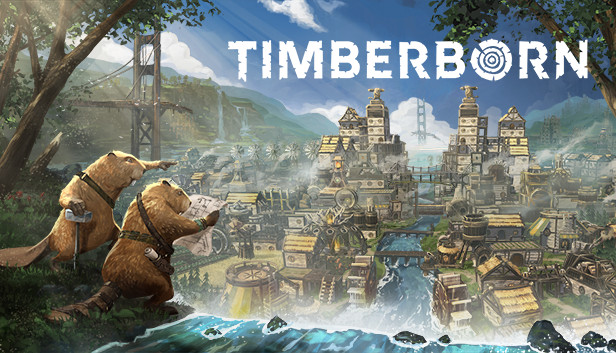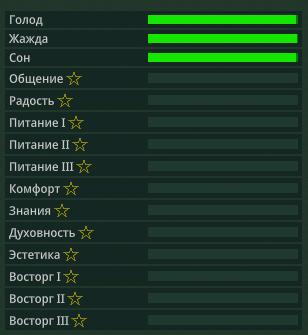
In this guide, you will find almost all the information on Timberborn.
Resources
Most resources are renewable, but it is still extremely important to properly allocate resources during the construction of our beaver. Consider the main types of resources:
![]() Wellbeing | Science | Materials (edit) | Food | Logs | Water
Wellbeing | Science | Materials (edit) | Food | Logs | Water
Let's discuss them in reverse order.:
Water:
This is the amount of water, which your beavers have accumulated in tanks all over the city using pumps.
Logs:
Logs – this is untreated wood, from which you can build the simplest buildings. You can make boards from them, and then – other materials. The number of collected logs depends on the type of tree.
Food:
Food – tasty, nutritionally and without it, your beavers will die very quickly. At first, make sure that your charges are picking berries. In the future, food will not be a big problem since potatoes and wheat will cover all the needs of the population..
Food and water form the backbone of your beaver civilization. The absence of at least one will lead to a sad end.
Materials (edit):
Materials (edit) – it is a general term for many other resources, which can be produced and stored. Some resources are a kind of intermediate link in the production chain., eg, raw potatoes become healthy food, when is it grilled. Some things are building materials, i.e, logs can be chopped into planks, what is the first necessary resource for the construction of advanced facilities.
Science:
Science points are created by inventors. These points can be used to unlock new buildings. Keep in mind, that some things may be unlocked out of order: eg, boards are required to build the platform. However, the platform can be unlocked before, how the boards will be created, which will lead to unlocked technology, which cannot be built.
Wellbeing:
Wellbeing – this is a general characteristic, defining, how happy is your population. The higher the score, the more productive our little hardworking aquatic dwarves will be. The thing is, that happiness consists of several requirements, and these requirements are set out in the tab, opening by clicking on the well-being statistics.
 Each individual stat has a bonus, ranging from lifespan gain to movement speed. Each of them satisfies a specific requirement, and none of them overlaps the other. So, Power I requires, for beavers to eat carrots, and for Meal II you need fried potatoes.
Each individual stat has a bonus, ranging from lifespan gain to movement speed. Each of them satisfies a specific requirement, and none of them overlaps the other. So, Power I requires, for beavers to eat carrots, and for Meal II you need fried potatoes.
You can highlight individual beavers, to assess their individual well-being, while clicking on the whole area, you will see the general well-being of the area.
Maximizing your well-being is not that hard, and this is very useful.
Beavers and resources
Beavers are by definition our most valuable resource. We talked about well-being above, now let's move on to other things, related to beavers.
Population:
 The beaver population is divided into "adults" and "children". Adults – this is your working population, and they can produce more children. For children, sure, need time, to grow up.
The beaver population is divided into "adults" and "children". Adults – this is your working population, and they can produce more children. For children, sure, need time, to grow up.
*******************
When it's time to sleep, your inhabitants can fall asleep anywhere, although, sure, they prefer to sleep in normal dwellings. Accommodation provides comfort – one of the indicators of well-being.
Providing adequate housing for our beavers is also important, because Folktail will reproduce offspring, only when additional housing appears. From experience we can say, that new beavers will not appear, if there is no suitable accommodation for them! It also means, that over-construction of housing can cause an explosion in fertility.
Note: the only way to get more beavers – it will produce more beavers. Seem to be, that they are sexless, therefore, any two beavers in one house with the possibility of rest and an empty place in the house will give birth to a child.
Employment:
***************
This tab will track the employment of the population. Unlike most simulators, unemployed population, seem to be, does not reduce the level of happiness. They'll mess around, eat food, drink water, visit entertainment venues and wait for work. The life of an unemployed beaver is good.
Yet every hand is needed for the cause, and it is very important to track unemployed beavers. Migration of the unemployed to underemployed areas is key to successful growth and expansion into new areas.
"Hidden" resources – these are resources, which are not clearly visible in the user interface or in the game itself. They are not secret, quicker, it may not be the right things, which you may need often, or which you even think about. However, this is important information., which you need to know about.
Land:
Probably, most obvious and yet, probably, land is extremely undervalued.
There are two types of earth: arable and non-arable.
Arable land green, this is due to the fact, that there is water nearby. The distance from the water to the end of the arable land may vary depending on the height of the terrain, type of water source, but not the depths of the source.
Pay attention to land in non-dry seasons. This land is valuable, as it is possible to grow agricultural plants on it. Track distance from rivers and lakes to the end of plowing, to choose the right place for the dam or change the river bed. The use of arable land for construction sometimes leads to problems with the production of food and wood.
To create more arable land, either irrigation towers must be used (only for Folktail):
Or build large structures, like an aqueduct:
Or terraform the area with dams and lakes.
However, non-arable land still has its value.. Firstly, it can be turned into arable land in various ways, as mentioned above, and others.
Also, ordinary land is useful for housing and industry., because the beavers don't care, what lands do they live on. Your search for non-arable land will lead you to discover great places to create residential areas.
This photo shows, that about half of the area's land will be arable, and about half – not. Try to focus the construction of buildings on non-arable land, so that arable land can be used in agriculture. The building stack mechanic can help you a lot with development..
And remember, what place, suitable for building, you can create:
Keep in mind, that some buildings must necessarily be built on solid ground, eg, bonfire and temple.
Knowing how to use the land effectively will increase our chances of survival.
Time:
Our residents will work on these hours, which we can adjust using the buttons +/-. The dark part of the circle, of course, night, and designed for sleep.
By default, our beavers will work 16 hours a day and sleep 8 hours. This leaves very little time for communication., resting or producing new beavers, if they can work or are not unemployed. Reduction of working hours to 15 or 14 hours will reduce the production of goods, but will allow the beavers to have free time.
If you have problems with population growth, make sure, that you have additional housing, and try to give the beavers time to rest.
Rivers, dams and waterways
Let's go over some of the basics of water mechanics, some general tips, then we will look at our structural elements and complete the construction with some buildings.
Water flow basics
This water game can be dealt with easily, and it more or less obeys the basic laws of physics.
Water flows from bottom to top.
Pushing water into tighter spaces makes the water flow faster (and can cause flooding).
If you give water a lot of space, so that it spreads, the water will slow down.
Check the terrain before building the dam.
Swimming!
Yes! Your beavers will swim! They will walk the paths, which may be underwater, and without much hesitation to complete the buildings, in the water. They also don't mind being in a flooded area.. However, at a certain water level, they look for higher ground and will not harvest crops or trees..
Construction from above
Beavers can build an object from above or below, which means, that they don't need direct access, to build something. They can place parts of the dam in the water several levels below them, or build something on a platform above them..
Dam (Dam)
Basic building block, used in hydraulic engineering. They allow water to flow from above, avoiding overflow. Dams are considered a solid object, that is, you can build buildings on them.
Dam (Levee)
The dam should be one of the first dam technologies unlocked, because the dams allow us to make a solid wall. Dams can be stacked on top of each other, and the water will stop flowing until then, until the reservoir overflows, and water will not flow over them. Dams and other objects can be placed on top of dams, but dams cannot be placed on top of anything else.
Gateway
Keeps water at a given level.
This is a dam
The first waterproof design, which we will produce, probably, there will be a dam.
Dam – it's a damn low building on the water, which stops or slows down the movement of water. At the start of the game, building a dam or two along the starting river will collect water for the summer. These buildings consist of dam elements (dam), crossing the river. This will slow down the movement of water and may cause, that your water wheels will stop flowing correctly.
In this image, you can see, that I replaced some parts of the building with dams (levee), to block part of the water flow. It means, that the water has fewer exit points, and it will flow a little faster in this area.
The dam will consist of several parts of the dam (levee) and plum, which will allow the water to go somewhere.
This dam has a two-level depth (about three – in the middle), therefore, during the dry season, the dam will hold a lot of water. Dams should be built at river mouths and used to create lakes behind them. Laying a dam on the river, important not to forget, so that the water flows out somewhere, otherwise there will be a flood.
To reduce flooding problems, you can make retaining walls next to the drain (as in the screenshot). Than water will be poured over a large area, the more the river will slow down.
Last but not least, you can make a gateway:
Aqueducts
Aqueducts – a great way to move water from one point to another.
As mentioned above, aqueducts create a lot of arable land, which is a huge help for agriculture. On the surface, they are expensive to manufacture and take up quite a lot of space.. Aqueducts can also be buried in the ground with explosives.
Pumping stations
There are water pumps, which pump water into the area to create an artificial lake.
Lake!
Remember, what can be built on lakes! You can create a lake, and then move production and houses to platforms on the surface of the water.
Lakes don't dry up in summer, and also bring a lot of water to beavers. But make sure, that water is successfully pumped from lakes to reservoirs – a big lake doesn't mean, that you have spare water at all!

Leave a Reply